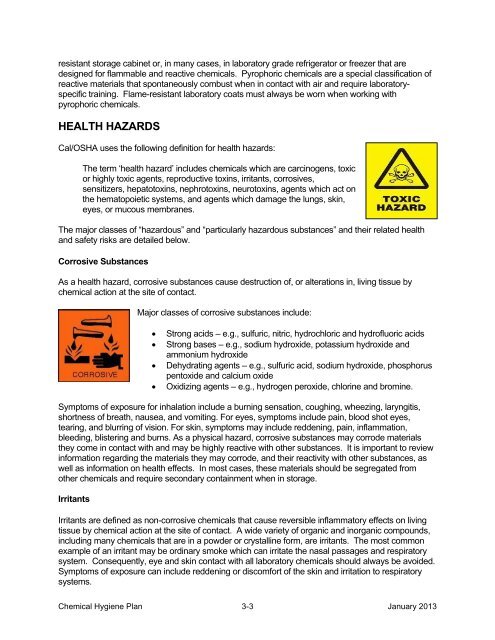Lab Safety Manual - UCLA - Environment, Health & Safety
Lab Safety Manual - UCLA - Environment, Health & Safety
Lab Safety Manual - UCLA - Environment, Health & Safety
You also want an ePaper? Increase the reach of your titles
YUMPU automatically turns print PDFs into web optimized ePapers that Google loves.
esistant storage cabinet or, in many cases, in laboratory grade refrigerator or freezer that are<br />
designed for flammable and reactive chemicals. Pyrophoric chemicals are a special classification of<br />
reactive materials that spontaneously combust when in contact with air and require laboratoryspecific<br />
training. Flame-resistant laboratory coats must always be worn when working with<br />
pyrophoric chemicals.<br />
HEALTH HAZARDS<br />
Cal/OSHA uses the following definition for health hazards:<br />
The term „health hazard‟ includes chemicals which are carcinogens, toxic<br />
or highly toxic agents, reproductive toxins, irritants, corrosives,<br />
sensitizers, hepatotoxins, nephrotoxins, neurotoxins, agents which act on<br />
the hematopoietic systems, and agents which damage the lungs, skin,<br />
eyes, or mucous membranes.<br />
The major classes of “hazardous” and “particularly hazardous substances” and their related health<br />
and safety risks are detailed below.<br />
Corrosive Substances<br />
As a health hazard, corrosive substances cause destruction of, or alterations in, living tissue by<br />
chemical action at the site of contact.<br />
Major classes of corrosive substances include:<br />
Strong acids – e.g., sulfuric, nitric, hydrochloric and hydrofluoric acids<br />
Strong bases – e.g., sodium hydroxide, potassium hydroxide and<br />
ammonium hydroxide<br />
Dehydrating agents – e.g., sulfuric acid, sodium hydroxide, phosphorus<br />
pentoxide and calcium oxide<br />
Oxidizing agents – e.g., hydrogen peroxide, chlorine and bromine.<br />
Symptoms of exposure for inhalation include a burning sensation, coughing, wheezing, laryngitis,<br />
shortness of breath, nausea, and vomiting. For eyes, symptoms include pain, blood shot eyes,<br />
tearing, and blurring of vision. For skin, symptoms may include reddening, pain, inflammation,<br />
bleeding, blistering and burns. As a physical hazard, corrosive substances may corrode materials<br />
they come in contact with and may be highly reactive with other substances. It is important to review<br />
information regarding the materials they may corrode, and their reactivity with other substances, as<br />
well as information on health effects. In most cases, these materials should be segregated from<br />
other chemicals and require secondary containment when in storage.<br />
Irritants<br />
Irritants are defined as non-corrosive chemicals that cause reversible inflammatory effects on living<br />
tissue by chemical action at the site of contact. A wide variety of organic and inorganic compounds,<br />
including many chemicals that are in a powder or crystalline form, are irritants. The most common<br />
example of an irritant may be ordinary smoke which can irritate the nasal passages and respiratory<br />
system. Consequently, eye and skin contact with all laboratory chemicals should always be avoided.<br />
Symptoms of exposure can include reddening or discomfort of the skin and irritation to respiratory<br />
systems.<br />
Chemical Hygiene Plan 3-3 January 2013
















